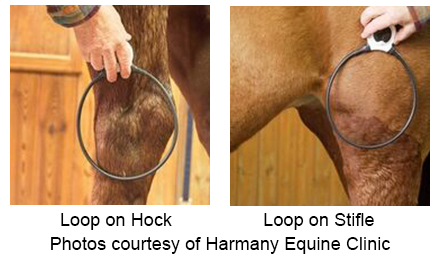
by Joyce Harman, DVM, MRCVS
PEMF (Pulsed Electromagnetic Field) therapies, the new “in” thing?
Pulsed Electromagnetic Field (PEMF) is one of the latest things in the horse world (and small animals too). Or is it? Actually, the equipment and techniques have been around for 70 years or more. Back then not much was known about how the devices worked, and what they really did in the body. Even when I finished veterinary school (back in 1984) the “Blue Boot” was a semi-portable, but expensive and cumbersome unit being used to heal non-union fractures.
The science and the devices have come a long way since then. Compact portable and affordable units are available as well as large units designed for use on the whole body. Units now can have many adjustments and come in all sizes and cost levels.
The good thing is that most PEMF devices do work and are a positive form of therapy that can be done by the animal’s owner.
What is PEMF?
The body is an electrical machine, with nerves conducting electricity to every cell. PEMF can enhance the transmission of the internal electrical charges that keep the cells running. Inside each cell there are many metabolic processes happening that all require cellular energy to fuel them. The PEMF wave improves the internal cellular energy.
Nitric oxide (NO) is actually a gas that operates in the body as a messenger, especially when tissue injury is present. It improves circulation which helps oxygenation of the tissues leading to improved healing. It can also have a direct effect on the pain receptors to relieve pain. Endorphins, which are our natural body opiates, can be increased also leading to pain relief, reduction of edema and swelling. Endorphins also help with bone healing and regeneration.
PEMF, being a magnetic wave, can penetrate hair, fur and bandage material, making it ideal for a veterinary setting. PEMF waves can target different tissues depending the internal charge of that tissue and the frequency of the unit. The instructions with the unit or the prescriber should tell you how to use it.
What can PEMF be used for?
The most common uses include pain and inflammation, however devices can be adjusted for nervous system tissue and used for calming. Since horses are so prone to injury, it helps with almost any type of tissue damage. PEMF can be very useful for localized pain in the foot, pastern, knee, hock and stifle. Laminitis cases can often gain benefit, either in the acute or chronic stage. Sometimes the increase in circulation is not useful in acute laminitis. It is best to consult your veterinarian.
Muscle, fascia and connective tissue (tendons and ligaments) can be more responsive to bodywork after being treated with PEMF.
What to look for in a device
There are several considerations as to what type of device you may want to use. All of the devices do have an effect on the body. Some are strong and require much care in their use, while some are mild in effect and may need hours of application.
Portable devices can be placed on any part of the body and held in place with tape for the duration of the treatment.
Large blanket type devices are expensive, and beyond what most people need and can afford. They have many adjustments so can be set for specific tissue effects. If you have a large blanket, it's also useful to have a smaller piece that can be put on a leg or small area to do a spot treatment.
Any cautions?
As with any tool, it is important to understand what you want to accomplish and how to use the device. The horses and other animals are normally accepting, and they often noticeably relax. If the settings are too strong, they will become uncomfortable. This is an indication that tissue damage can be happening, rather than tissue healing. With PEMF more is not better according to the research and can be harmful to the tissue metabolism. Too intense a treatment can increase cellular stress over time and result in less cellular health.
This article is from Harmany Equine ClinicHarmany Equine Clinic and is published here with permission.
Find more informative articles in our section on Health & Education.
Video of a simple, effective PEMF Tool

































